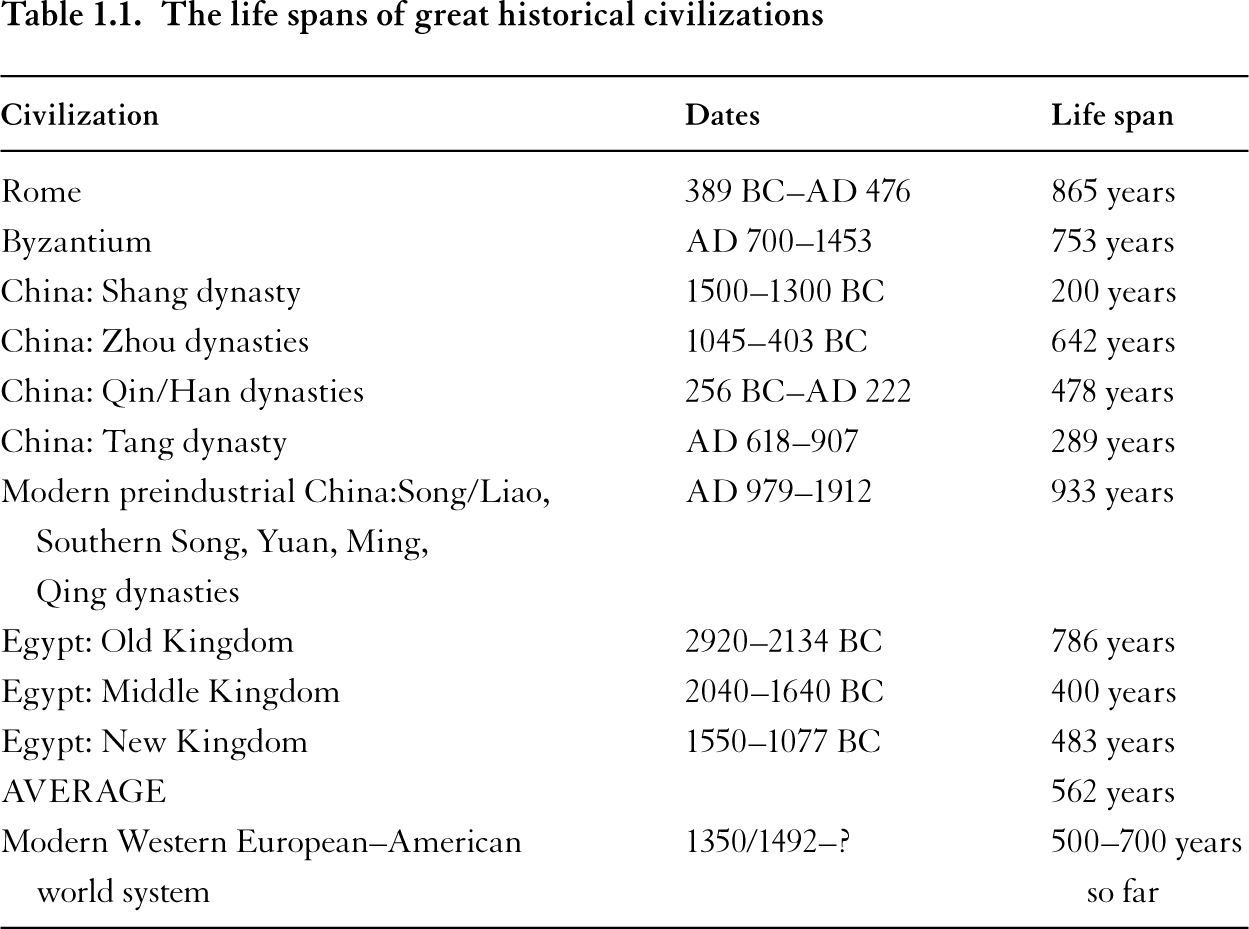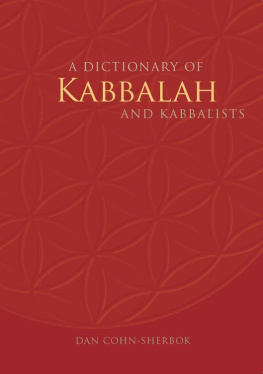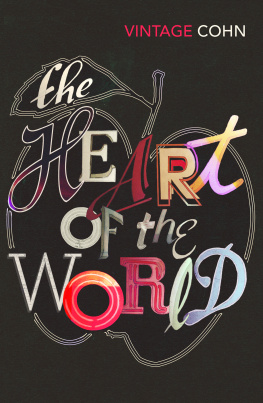Chapter 1
A LL S OCIETIES D IE
All societies die. We like to pretend they dont. We also like to pretend that we as individuals arent going to die either. But no human being lives forever. Neither do societies, empires, or civilizations.
How long will our current civilization live? By historical comparative standards, European-American civilization is middle aged. One can get a sense of the life spans of civilizations by seeing how long other civilizations survived. shows how long some of the great societies of the past were able to maintain themselves.
If you look at the Roman Empire, the Byzantine Empire, the various dynasties of China, and the Old, Middle, and New Kingdoms of Egypt, these empires lasted an average of a little over 550 years. Rome had a long life at about nine hundred years. China has been doing well since AD 979, with several consecutive dynasties being essentially prosperous. There was a collapse in 1911 with the onset of the Chinese Revolution, but otherwise Modern China had a life of over nine hundred years.

Other empires were not so lucky. Byzantium had only five hundred years of true independence. In its last few hundred years of existence, it was dominated by the Italians. The Shang dynasty of China ran only two hundred years. Neither the Middle nor the New Kingdom of Egypt survived five hundred years. There were flash-in-the-pan empires, like Alexander the Greats, which collapsed soon after the death of Alexander himself.
Where do we stand in all of this? Modern Western civilization dates from the end of the Middle Ages. There was a steady process of economic and technological growth, which gave us our current high standard of living. If one dates this transition from the onset of European world dominanceChristopher Columbuss discovery of Americawe are approximately five hundred years old. I take the economic growth of the fourteenth and fifteenth centuries seriously. So, I would date the modern world system from 1350, making us 650700 years old. That would give us the average length of age of an empire when it fallsalthough many empires last much longer.
The experiences of other empires would suggest that the West should expect a life of no more than five hundred to eight hundred years, with a chance of an earlier extinction. The eight hundred figure is very optimistic.
What does the death of a society or civilization mean? The fall of the Roman Empire led to the Middle Ages. In China, the collapses at the end of dynasties are known as Warring States periods. The periods between Egyptian kingdoms were chaotic.
All of the following things have occurred during feudal chaotic periods:
Standards of living collapse. Under the empire, trade is possible. Under the empire, there is a market demand for goods and services at least in the capital city and often in the outlying territories as well. This all dries up when military chaos makes trade no longer possible. Commerce disappears. Manufacturing disappears. Food supplies dry up. The world sinks into poverty.
Technology disappears. We currently live in a world where technology just keeps getting better and better. Do you have an incurable disease now? Dont lose hope! In ten or twenty years, someone might invent something that will fix you. But there is no sacred rule that scientific skills improve all by themselves. Sometimes technology stagnates. Sometimes there is outright technological loss as the skills needed to manufacture vital products becomes lost.
Imagine you live in some sort of postnuclear devastated world. Do you know how to make antibiotics? Could you build an electrical generator? Would you know how to drill for petroleum?
Science is hard. Most people struggle with their math or chemistry classes. It is difficult to reproduce each new generation of scientists, engineers, and technicians on which our world depends.
Crime, warfare, and violence increase. Large secure states mean peace and rule of law within their boundaries. When the state collapses, criminals and invaders run wild.
Rome was not a tranquil place. It had its civil wars. But during the peaceful years, which were most of them, the roads were patrolled. Invasions affected the frontiers but not the heart of the empire.
In medieval Europe, a state could be the size of a handful of counties. Wars between microlords were endemic. Pirates ruled the oceans. There were raids from barbarians or from stronger geopolitical powers in Spain or Turkey. In that era, there was no calling the police or calling in the National Guard. If there were thieves or invaders, individual farmers had to defend themselves.

Societal death is grim. It is also inevitable. But this doesnt mean death has to come soon. Under ideal circumstances, the European-American world system could last for several centuries more.
But if we want our current civilization to live, it helps to know what exactly kills societies, empires, and civilizations. We need to know how to keep our societies alive. You cannot keep your own society alive if you do not know what kills societies in general.
Chapter 2
I S A F ALL R EALLY A F ALL?
How bad is it for a society to fall? After all, Rome fell; the Egyptian kingdoms fell; various Chinese dynasties fell. But ultimately those places recovered. Currently the world is enjoying a higher level of prosperity and technological sophistication. That includes Italy, Egypt, and China.
There is even a contrarian line of scholarship that claims Rome did not really fall. To be sure, a region that was once governed by Italians came to be governed by Germanic tribes. The contrarians claim the rise of the Goths meant personal liberation and freedom, while nothing else really changed.
I disagree with the contrarians. Falls of nations and empires really are falls. In the case of Rome, all evidence suggests there was a dramatic reduction in economic activity and standards of living.
One simple indicator of how much wealth people had is the quantity of pottery remains. Pottery is more useful than other material indicators. Wood and clothing rot over time. Gold and silver are often melted and reused. Pottery lasts forever, at least as shards. Households during the Roman Empire had lots of pottery. After the fall, the number of shards drops dramatically.
Another indicator of economic activity is coinage. Gold and silver coins are relatively plentiful during the Roman Empire. They are much rarer in the 500800s.
Populations were smaller after the fall of the Roman Empire. One can assess this by looking at the number and size of houses and calculating the likely numbers of occupants. Some of the population loss may have come from warfare or from an increase in plagues. Warfare and epidemics produce one-shot crisis reductions in population size. Reductions in food supply produce enduring high mortality and population shrinkage. Poverty and malnutrition may have easily contributed to the population shrinkage in Europe.














